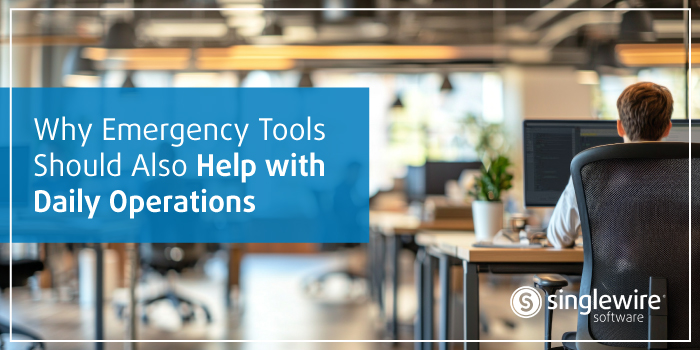Supporting Safety and Productivity
Organizations often invest in emergency communication tools with one goal in mind: to respond quickly and effectively when a crisis occurs. That’s a critical function, but emergencies are rare. How are those systems used during the majority of the time when emergencies aren’t occurring?
If your tools sit idle until something goes wrong, you’re not getting the full value from your investment. The right communication platform can do far more than handle emergencies—it can become a core part of your organization’s daily operations.
Let’s explore how modern notification tools can reduce manual work, improve coordination, and support safety and productivity in day-to-day scenarios.
The Limitations of Emergency-Only Systems
Many emergency systems are built to serve a single purpose: crisis response. They’re set up to be used in case of a fire, active shooter, medical emergency, or other critical events that threaten people’s well-being or an organization’s ongoing operations. But outside of those situations, testing, or drills, these tools can often go unused.
That creates a few key problems:
- Underutilized technology offers little ROI, meaning resources are wasted or not optimized
- Systems become outdated, leading to tools that are difficult to maintain or lack the ability to integrate with new solutions.
- Staff unfamiliarity due to infrequent use can cause delays when systems need to be activated, putting people and operations at risk.
When systems are siloed and reserved for rare scenarios, it’s easy for them to become obsolete, ignored, or misunderstood.
Creating Smarter Daily Communication
The most effective communication platforms work just as well during day-to-day operations as they do during emergencies. Here are a few ways organizations are using mass notification and incident management tools every day:
1. Coordinating Staff Across Shifts and Locations
When you need to notify a team about a schedule change, room relocation, or last-minute update, sending a quick message through a unified communication system can save time and reduce confusion.
- Alert staff about early dismissals or schedule changes
- Coordinate delays or facility closures
- Notify maintenance teams of urgent tasks
Instead of relying on email chains or individual calls, messages can be sent instantly to relevant groups based on location, department, or role.
2. Automating Routine Notifications
Daily announcements, maintenance alerts, and reminders can be automated using templates and scheduling tools built into modern notification systems.
- Schedule end-of-day facility closure announcements
- Send recurring reminders for compliance checks
- Alert teams to weather-related delays or travel restrictions
These small but frequent tasks add up. Automating them frees up staff time and ensures consistency.
3. Streamlining Visitor and Contractor Management
Emergency tools integrated with visitor management systems can improve the guest experience and enhance security.
- Pre-register visitors and notify hosts automatically
- Alert security or facilities teams when contractors arrive
- Log entries and exits without requiring manual sign-ins
This doesn’t just speed up the check-in process—it also gives you better visibility into who’s in your building at any time.
4. Improving Internal Communication
Whether you’re dealing with delayed shipments, system outages, or weather-related closures, the ability to quickly notify affected teams prevents delays and confusion.
- Communicate IT outages or software downtime
- Alert employees to route closures or parking issues
- Share internal updates with remote or hybrid staff
With options for mobile alerts, desktop pop-ups, and on-site announcements, messages can reach everyone, not just those at their desks.
5. Testing and Training Without Disruption
One overlooked benefit of using communication systems regularly is that staff become more familiar with how they work. This makes testing and emergency preparedness smoother and more effective.
- Conduct system checks during non-peak hours
- Run drills using real tools without disruption
- Identify areas for improvement through usage data
The more your team interacts with the platform, the more confident they’ll be when it counts.
The Value of a Unified Communication Platform
A system that only does one thing well isn’t enough anymore. Today’s organizations need flexible platforms that add value across many use cases.
When your emergency tools also serve operational needs, you:
- Get better ROI from your technology investment
- Build trust and familiarity among staff who use the system regularly
- Reduce reliance on ad hoc workarounds like group texts or manual emails
- Make your organization more agile and responsive
Plus, using the same system daily ensures it’s maintained, updated, and ready to perform when a real emergency happens.
What to Look For in a Multi-Purpose Notification System
If you want a tool that supports both emergency response and daily communication, look for features like:
- Role- or location-based targeting for specific messages
- Support for mobile, desktop, and in-building notifications
- Integration with existing technology to reduce the need to rip and replace
- Easy-to-use interface with templates and scheduling options
- Two-way communication for feedback and acknowledgments
Make sure the system fits into your broader operational and safety strategy, not just your emergency plan.
Rethinking the Role of Emergency Communication
Your emergency tools don’t have to gather dust until something goes wrong. Used correctly, they can become a powerful part of your day-to-day communication toolkit—improving coordination, saving time, and supporting a safer, more efficient workplace.
Because tools that only work in a crisis aren’t enough. The right system works every day to keep your organization informed, connected, and ready for whatever comes next.
Interested in how one solution can support both safety and operations? Visit our InformaCast page to learn more.
